This report analyzes multiple DeFi protocols from a financial perspective, including Aave, Maker, Lido, and ether.fi, providing a technical overview and financial data estimates, revealing the profit transformation and future potential of each protocol.
Author: @Kairos_Res
Translation: Blockchain in Plain Language
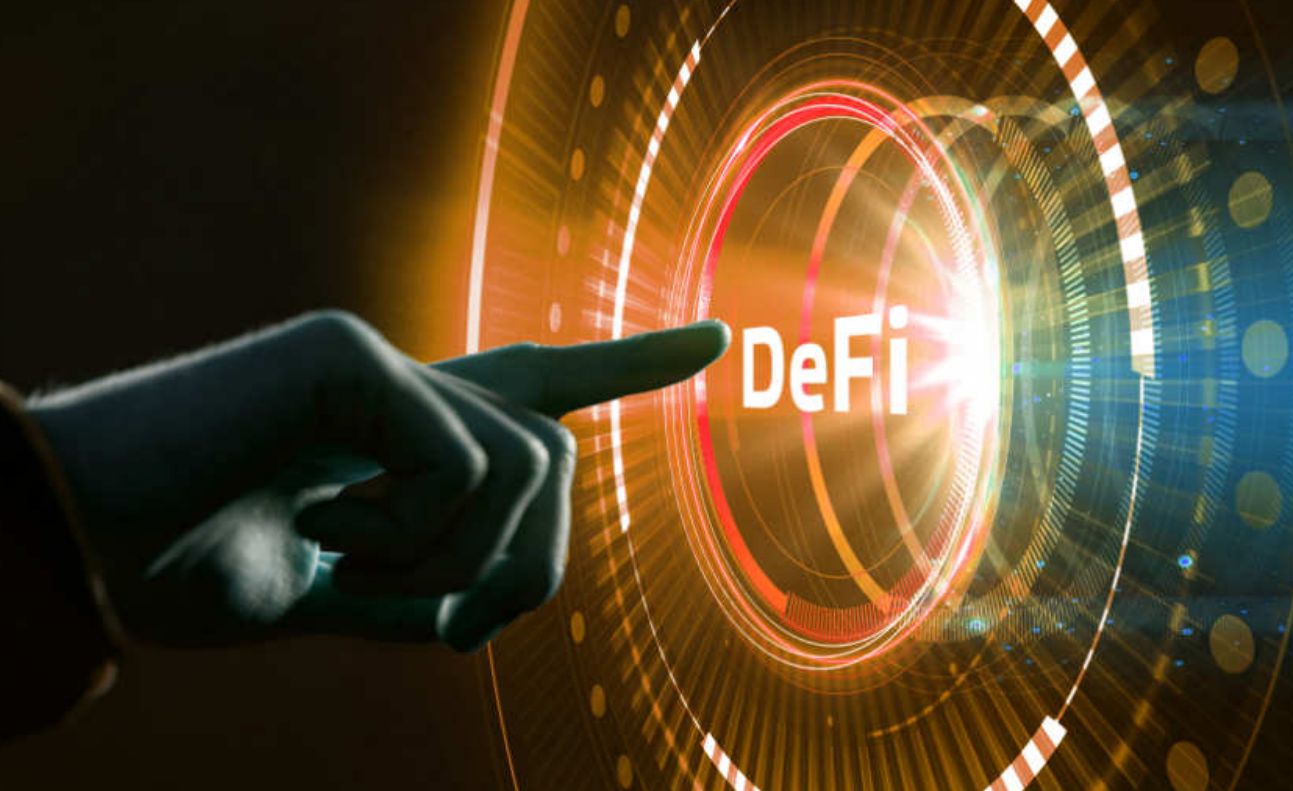
The following report aims to explore some of the most influential DeFi protocols from a financial perspective, including a brief technical overview of each protocol, as well as an in-depth analysis of their revenue, expenses, and token economics. Since we could not obtain audited financial statements, we estimated the full-year financial reports for Aave, Maker (Sky), Lido, and ether.fi using on-chain data, open-source reports, governance forums, and conversations with project teams.
The table below presents our most important findings during the research process, providing readers with a high-level overview of the current status of each protocol. While revenue multiples are a common method for assessing overvaluation and undervaluation, key considerations regarding dilution, new product lines, and future revenue potential present a more complete story.
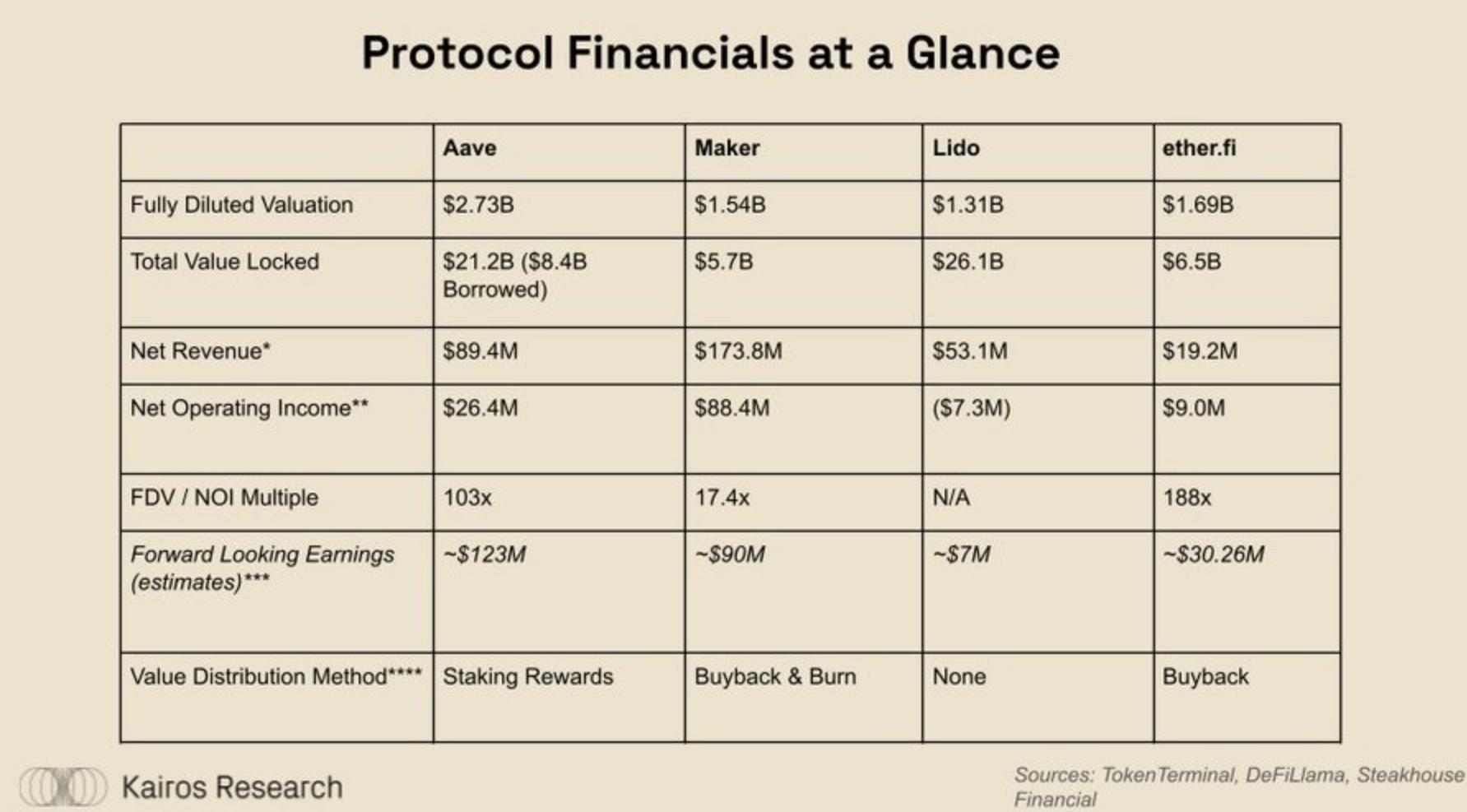
The DAI savings rate has been included in the revenue costs, but Aave's safety module is not included.
Token incentives for ether.fi are excluded as they exist in the form of airdrops.
This is a very rough estimate, using growth rates, interest rates, Ethereum price increases, and profit margin estimates for new products (GHO, Cash, etc.), and should not be considered investment advice.
Aave is currently considering redesigning its token economics to include AAVE buybacks and distributions.
Through our analysis, we conclude that multiple protocols are undergoing a transformation towards sustainable profitability, a process that has taken place after years of liquidity guidance and barrier building. Aave appears to have reached a turning point, achieving profitability for the first time and quickly launching a new high-margin borrowing product, GHO. Ether.fi is still in its early stages, but its TVL has exceeded $6 billion, placing it among the top five protocols. This leader in liquidity re-staking has also learned from some of Lido's shortcomings, launching a series of other high-margin auxiliary products to maximize their billions in deposits. Read the full report for a better understanding of our calculations, estimates, and the efforts made by various communities to drive the value of their protocols.
1. Problem Statement and Definitions
Since the rise of DeFi in 2020, on-chain data and analytics have continuously improved, with platforms like Dune, Nansen, DefiLlama, TokenTerminal, and Steakhouse Financial playing a key role in creating real-time dashboards for crypto protocols. At Kairos Research, we believe that driving standardization within the industry is an important step in enhancing credibility, as it can showcase financial performance, health, and sustainability. Profitability is often overlooked in the crypto space, but value creation is the only way to sustainably coordinate the various participants (users, developers, governance, and community) within a protocol.
Here are some definitions we will use in our research and financial statements, aimed at standardizing similar costs across various protocols.
Gross Revenue/Expenses: This includes all revenue generated by the protocol, belonging to the users of the protocol and the protocol itself.
Commission Rate: The percentage of fees charged to users by the protocol. Net Profit: The revenue left to the protocol after paying user fees and considering revenue costs. Operating Expenses: Broad protocol expenditures, including payroll, contractors, legal and accounting, auditing, gas costs, grants, and possibly including token incentives. Net Operating Income: The bottom-line dollar figure after deducting all costs incurred by the protocol and token holders, including token incentives related to protocol operations. Adjusted Earnings: Adding one-time expenses to earnings to more accurately predict future earnings, minus known future costs that are not currently represented by earnings.
2. Protocol Overview
In this report, we will provide a high-level analysis of the core products of each key protocol, selected from the most influential protocols across various crypto sub-industries.
1) Aave
In short, Aave is a “decentralized, non-custodial liquidity protocol where users can participate as suppliers, borrowers, or liquidators.” Suppliers deposit crypto assets to earn borrowing yields and enhance their borrowing capacity, allowing them to utilize or hedge their deposited positions. Borrowers can be over-collateralized users seeking leverage and hedging, or arbitrage traders utilizing atomic flash loans. To borrow against crypto collateral, Aave users must pay a fixed or floating interest rate on specific assets. Aave's protocol fees are the total interest paid on open (unrealized), closed, or liquidated positions, which are then distributed between lenders/suppliers (90%) and the Aave DAO treasury (10%). Additionally, when a position exceeds its specified loan-to-value maximum, Aave allows “liquidators” to close that position by taking on the collateral risk and repaying the remaining debt.
Each asset has its own liquidation penalty, which is also distributed between liquidators (90%) and the Aave DAO treasury (10%). A new product offered by Aave is an over-collateralized crypto-backed stablecoin called GHO. The introduction of GHO allows Aave to provide loans without requiring stablecoin suppliers on the other end of the transaction, giving them more flexibility in interest rates while eliminating intermediaries and earning 100% of the borrowing interest on any outstanding GHO loans.
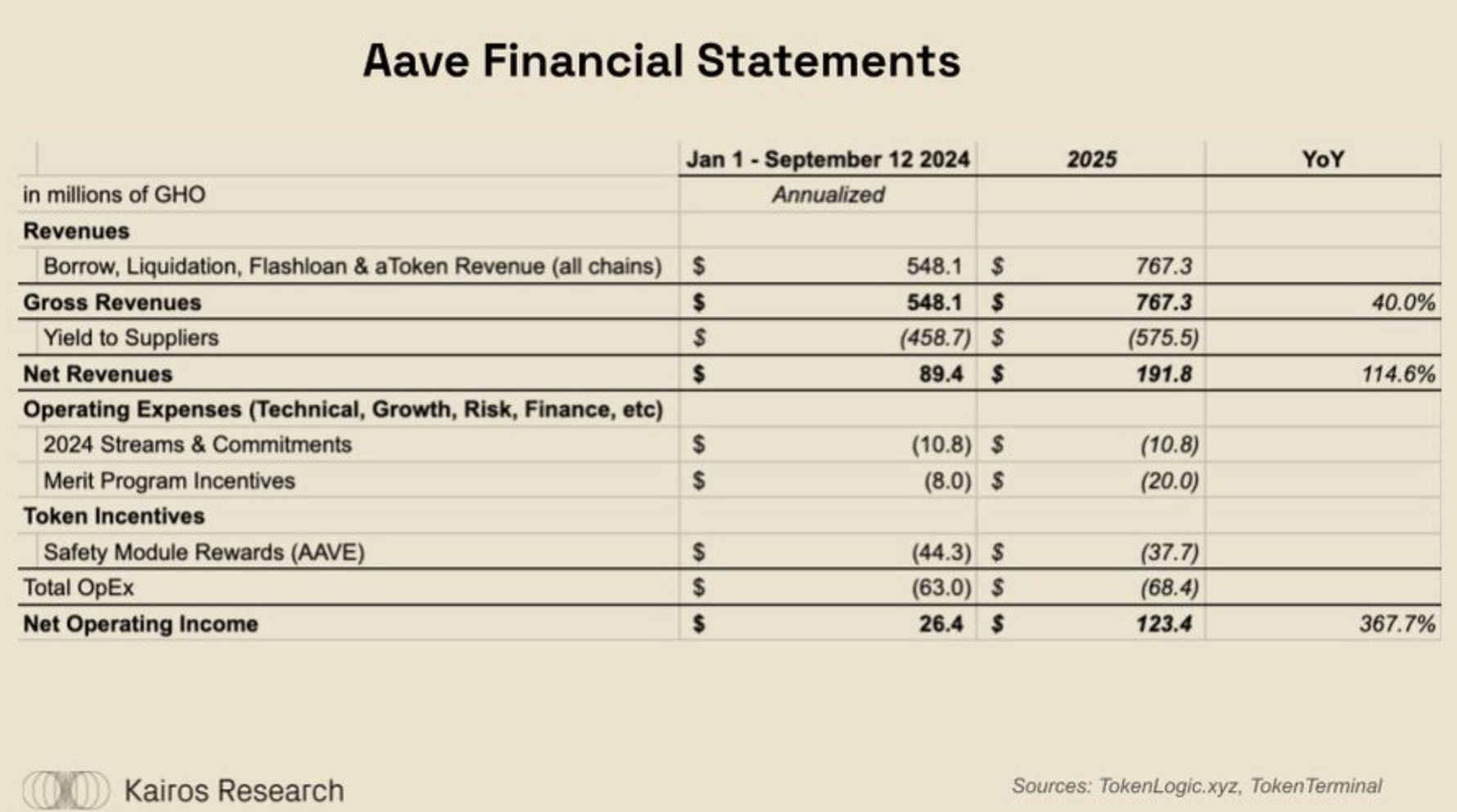
Aave transparently displays all income, expenses, and current operational data of the DAO through the Tokenlogic dashboard. We were able to extract “treasury income” data from August 1 to September 12 and apply a multiplier for annualization, resulting in a net income of $89.4 million. To calculate total revenue, or gross revenue, we relied on revenue report data from TokenTerminal to estimate profit margins, as Aave's revenue structure is no longer simply 90%/10%, but has become more complex due to distributions between the traditional borrowing market, liquidations, and GHO borrowing. Our 2025 forecast is primarily based on several assumptions, including a relative upward trend in crypto asset prices, which will enhance borrowing capacity. Additionally, as borrowing is expected to shift more towards GHO rather than third-party stablecoins, and improvements to the protocol's safety module are anticipated, Aave's net profit margin in our model has also increased, which will be further explained later.
The leading borrowing market in cryptocurrency is expected to see its first profitable year in 2024, as supplier incentives have decreased while active loans continue to grow, with the current active borrowing amount exceeding $6 billion. Aave is clearly a significant beneficiary of the liquid staking and re-staking market, as users deposit liquid staking tokens (LST)/liquid staking receipts (LRT), borrow Ethereum, and then exchange Ethereum for liquid staking tokens, repeating this process. This is known as a circular operation, allowing Aave users to generate net interest spreads (annualized yield of liquid staking token/LRT deposits minus Aave's borrowing interest) without taking on significant price risk.
As of September 12, 2024, Ethereum is Aave's largest outstanding borrowing asset, with active loans across chains exceeding $2.7 billion. We believe this trend is benefiting from the proof-of-stake + re-staking concept, which has changed the landscape of the on-chain borrowing market, allowing protocols like Aave to significantly increase utilization in a relatively sustainable manner. Before the popularity of circular operations, these borrowing markets were primarily dominated by users seeking leverage on crypto assets, who often only borrowed stablecoins as their investment tendencies leaned heavily towards long positions.
The introduction of GHO has created a new high-margin borrowing product for Aave. It is a synthetic stablecoin, and borrowing costs do not need to be paid to suppliers. This also allows the DAO to offer loans slightly below market rates, thereby driving borrowing demand in other challenging environments. From a financial perspective, GHO is undoubtedly one of the most important aspects to monitor in the future for Aave, as this product possesses:
High upfront costs (technology, risk, and liquidity)
Audits, development work, and liquidity incentives will continue to slowly dissipate over the coming years
Significant relative upside potential
Outstanding GHO supply of $141M, accounting for only 2.35% of Aave's total outstanding loan balance and 2.7% of outstanding DAI supply
Nearly $3B of non-GHO stablecoins (USDC, USDT, DAI) are currently borrowed on Aave
Profit margins higher than Aave's loan market
While other costs need to be considered when issuing stablecoins, it should be cheaper than needing to pay suppliers
Maker DAO's net income profit margin is 57%, while Aave's net income profit margin is 16.31%
The protocol's native token AAVE is trading at a fully diluted valuation (FDV) of $2.7 billion, with an estimated annual revenue of $26.4 million, approximately a 103x price-to-earnings ratio. However, we believe this multiple may effectively compress in the coming months. As mentioned earlier, favorable market conditions should enhance borrowing capacity, stimulate new demand for leverage, and potentially accompany liquidation income—this income is relatively low in 2024. Finally, even if GHO's market share growth is merely an erosion of stablecoins in Aave's traditional borrowing market, it should have an immediate positive impact on profit margins.
2) MakerDAO
The Maker Protocol is a decentralized organization that issues the stablecoin DAI, supporting various crypto and real-world collateral, enabling users to leverage their assets and provide a "decentralized" stable value store for the crypto economy. The protocol fees for Maker consist of the "stability fees" paid by borrowers and the income generated from the protocol's allocation of yield-generating assets. These protocol fees are distributed between MakerDAO and depositors who deposit DAI into the DAI Savings Rate (DSR) contract, with the specific ratio depending on the DAO. Similar to Aave, MakerDAO also charges liquidation fees. When a user's position falls below the required collateral value, the loan will be closed through an auction process, and the protocol will extract a portion from the remaining position value to mitigate liquidation and protocol pressure.
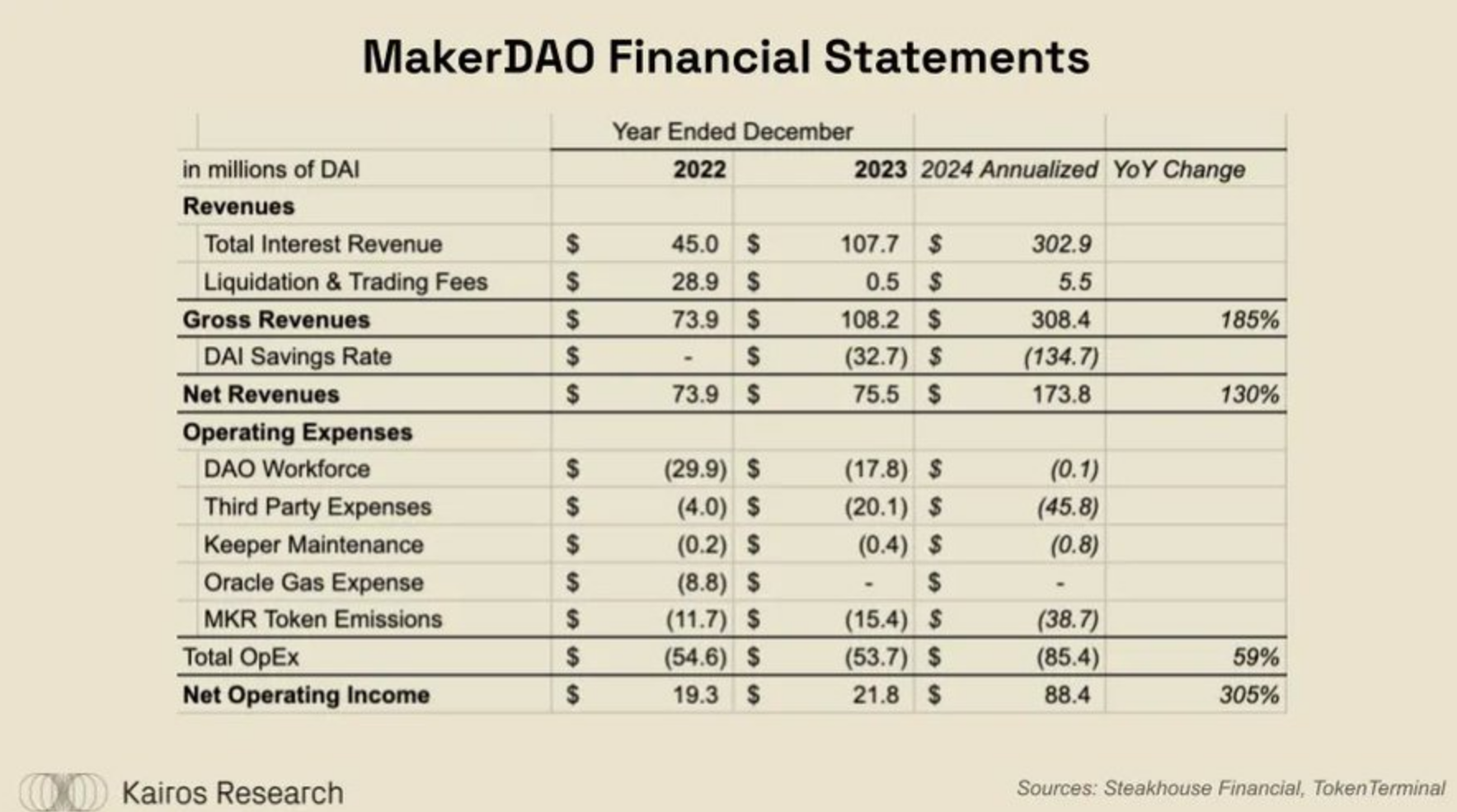
MakerDAO has thrived over the past few years, benefiting from liquidations during the speculative volatility of 2021, while also creating a more sustainable and lower-risk business line due to rising global interest rates. The introduction of new collateral assets, such as U.S. Treasury bonds and USDC, has allowed Maker to generate yield on its assets, achieving returns beyond the standard DAI borrowing rates. In analyzing the DAO's expenditures, we found several obvious points:
DAI is deeply embedded in the entire crypto ecosystem (CEX, DeFi), allowing Maker to avoid issuing millions of dollars in liquidity incentives. The DAO has done an impressive job prioritizing sustainability.
In 2024, Maker is expected to generate approximately $88.4 million in net protocol income. Considering the valuation of MKR at $1.6 billion, its trading multiple is 18 times net protocol income. In 2023, the DAO voted to reshape the protocol's token economics to return a portion of the income to MKR holders. As DAI continues to accumulate through ongoing borrowing rates (stability fees), Maker has established a target system surplus of around $50 million. Maker's smart burn engine utilizes this surplus to buy back and burn MKR through surplus auctions. According to Maker Burn data and Steakhouse's visualization, 11% of the MKR supply has been repurchased and used for burning, liquidity owned by the protocol, or treasury building.
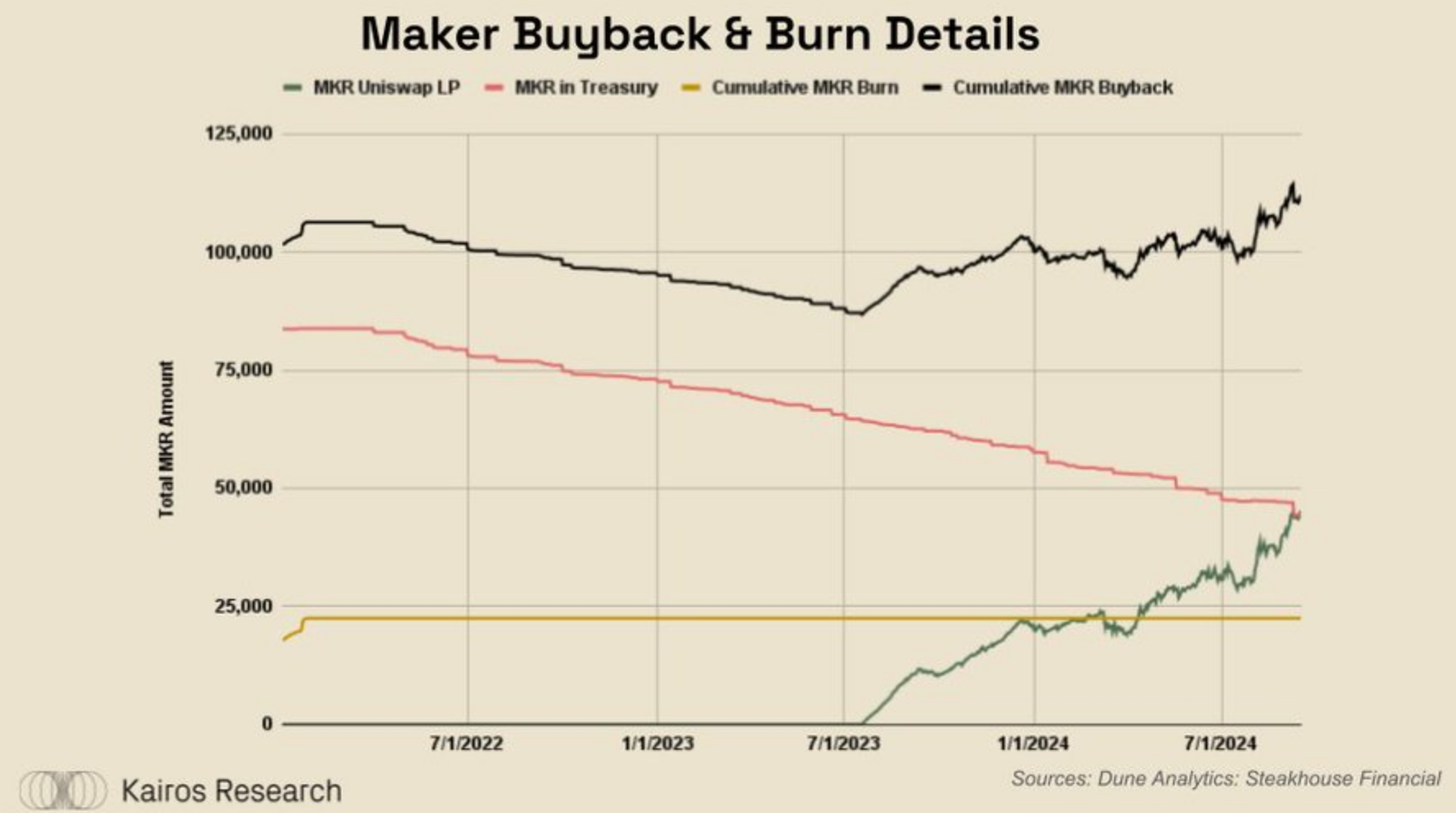
3) Lido
Lido is the largest liquid staking provider for Ethereum, connecting ETH holders with a decentralized network of validators willing to stake their assets. When users stake ETH through Lido, they receive a "liquid staking token," which is a fungible representation of their underlying staked balance, thus avoiding the opportunity cost of queuing for unstaking and being unable to use staked ETH in DeFi. Lido's protocol fees come from the ETH yields used to validate the network, which are distributed among stakers (90%), node operators (5%), and the Lido DAO treasury (5%).
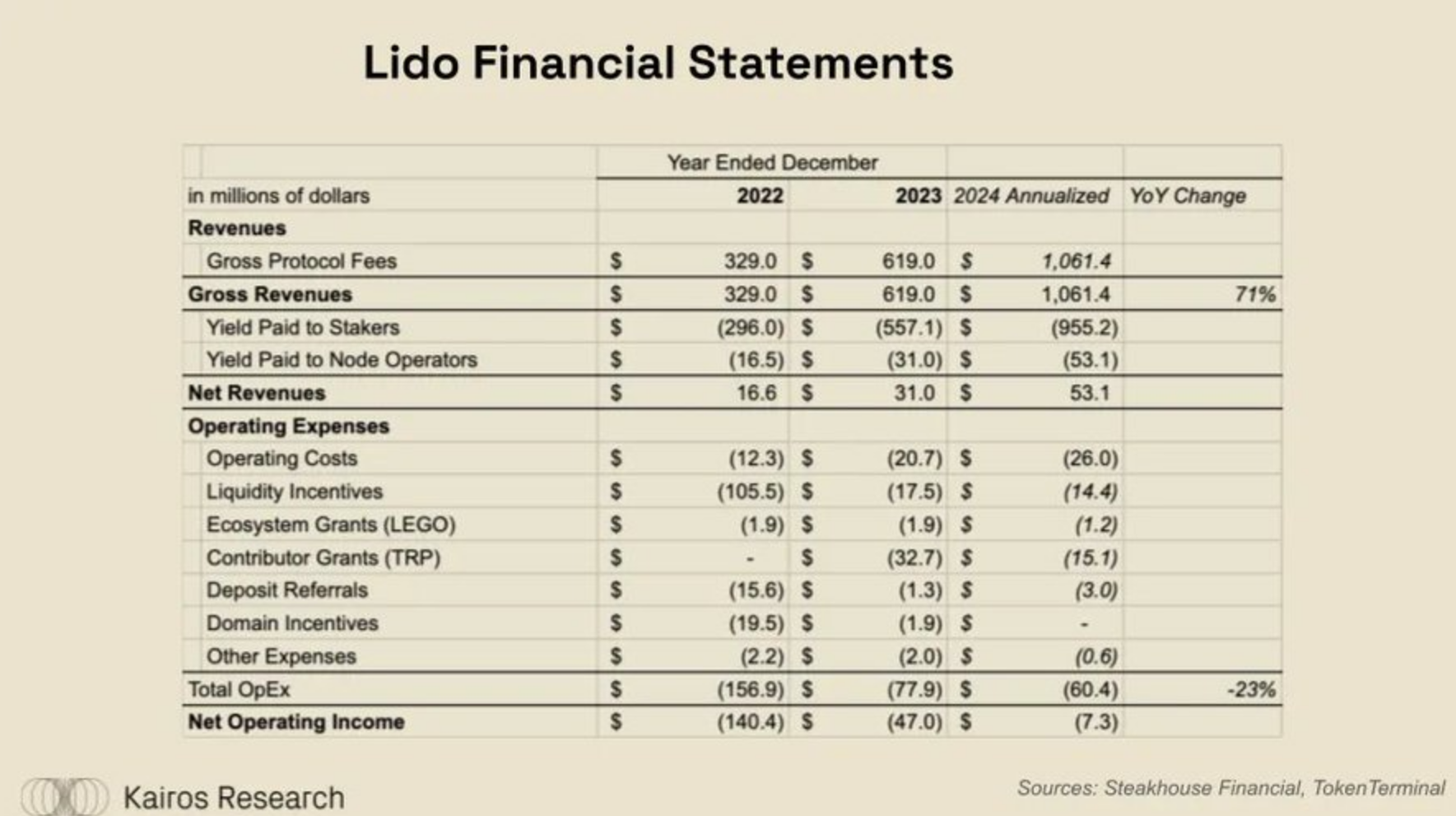
Lido is an interesting case study in DeFi protocols. As of September 10, 2024, they have staked 9.67 million ETH in the protocol, accounting for about 8% of the total ETH supply, and hold over 19% of the staking market share. With a total locked value of $22 billion, few other protocols can control the market as effectively as Lido. However, as noted above, they have yet to achieve profitability. So, how can Lido ensure cash flow in the short term?
Several changes can be considered:
Adjusting the protocol fee structure: By increasing the yield distribution ratio to stakers or reducing the share for node operators, Lido may attract more stakers, thereby increasing total revenue.
Increasing product diversity: Launching new financial products or services, such as staking loans, allowing users to borrow liquidity while staking ETH, thereby expanding the user base and revenue sources.
Optimizing operational costs: Analyzing current operational and technical costs to seek opportunities for cost reduction, improving overall profitability.
Expanding market share: Actively promoting the advantages of liquid staking, especially in new DeFi projects, to expand market influence and attract more users.
Introducing additional revenue sources: For example, participating in revenue sharing from DeFi protocols or collaborating with other projects to increase non-traditional revenue.
Through these changes, Lido can enhance its financial position and achieve profitability in the short term.
Over the past two years, the DAO has made significant progress in reducing costs. Liquidity incentives have been crucial in driving the use of stETH, as core users naturally tend to use the liquid staking token with the highest liquidity in the ecosystem. We believe that as stETH demonstrates a strong moat, the DAO will be able to further reduce this expenditure. If Lido were to completely eliminate liquidity incentives like Maker, we estimate they could achieve profitability in 2024. However, even with cost reductions, a profit of $7 million may not be sufficient to justify LDO's fully diluted valuation of over $1 billion.
In the coming years, Lido must seek expansion or cost-cutting to align with its valuation. We see several potential growth paths for Lido, either through an increase in the staking rate of the Ethereum network from 28.3% or Lido's efforts to expand beyond the Ethereum ecosystem. We believe the former is quite likely over a longer time frame. In comparison, Solana's staking rate is 65.5%, Sui's is 79.5%, Avalanche's is 49.2%, and Cosmos Hub's is about 61%. If Lido can double the amount of staked ETH while maintaining market share, they could generate over $50 million in net income to offset costs. This assumption is overly simplistic, not accounting for the compression of ETH issuance as staking rates rise. While enhancing current market share is also possible, we see that the Ethereum community consensus regarding Lido's dominance has become very skeptical in 2023, marking the peak of its rapid growth.
4) ether.fi
Like Lido, ether.fi is also a decentralized, non-custodial staking and re-staking platform that issues liquid receipt tokens for users' deposits. The protocol fees for ether.fi include ETH staking yields and income from active validation services provided through the Eigenlayer ecosystem for economic security. These fees are divided into ETH staking yields, distributed at 90% (stakers), 5% (node operators), and 5% (ether.fi DAO); and Eigenlayer/re-staking rewards, distributed at 80% (stakers), 10% (node operators), and 10% (ether.fi DAO).
ether.fi also has several auxiliary products that generate significant income, including "Liquid," which is a treasury of re-staking and DeFi strategies designed to maximize depositor yields. Liquid charges a management fee of 1-2% on all deposits, which accumulates back to the ether.fi protocol. Additionally, ether.fi recently launched Cash, a debit/credit card product that allows users to spend their re-staked ETH or use it as collateral for real-life purchases. Cash enables users to earn cash back and avoid cryptocurrency withdrawal and gas fees, provided that fees are paid in ETH annually.
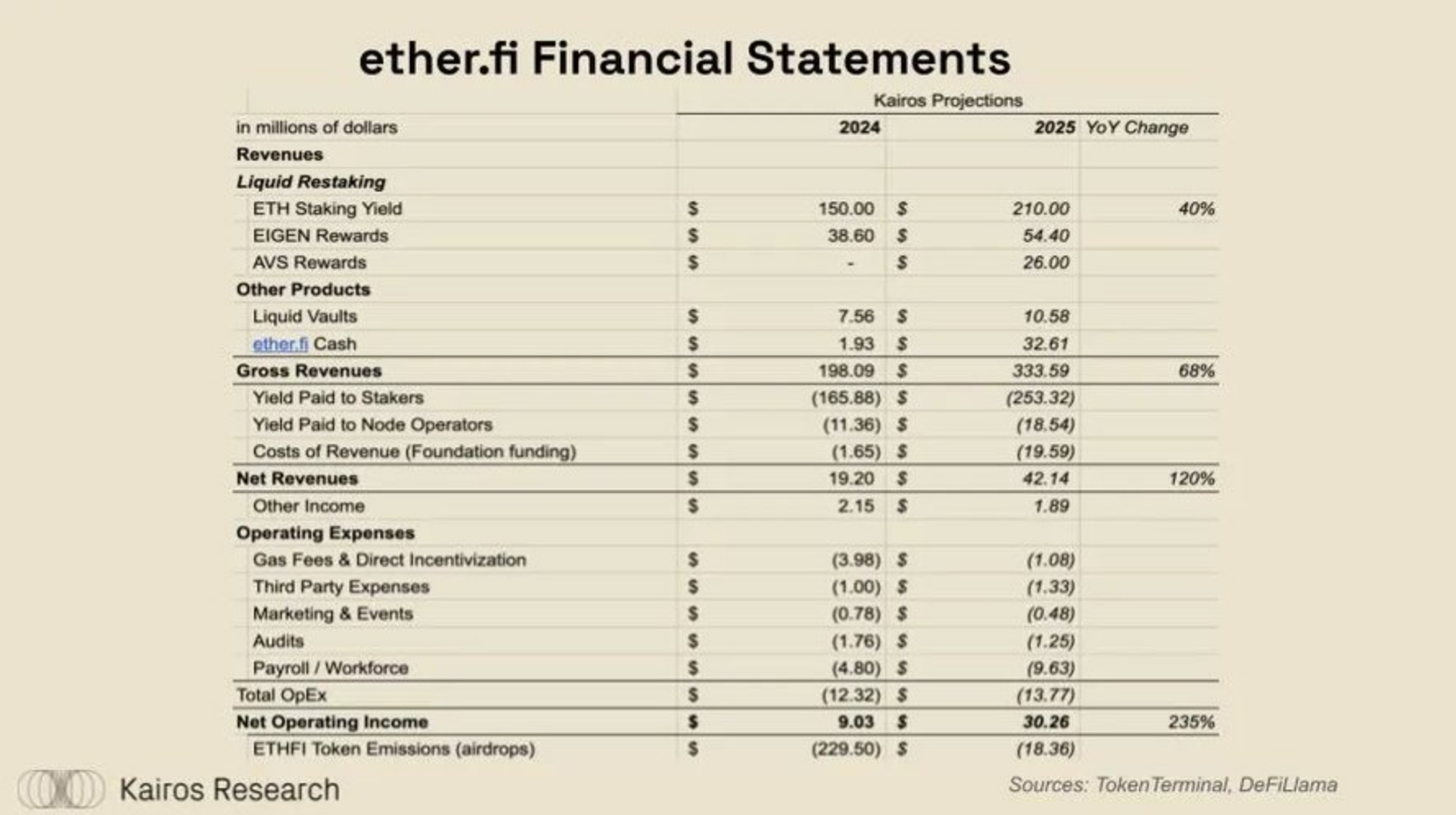
As of September 2024, ether.fi indisputably holds a market leadership position in the liquid re-staking space, with a total value locked (TVL) of $6.5 billion in its re-staking and yield products. We attempted to model the potential protocol income for each product in the above financial statements, using the following assumptions:
The average TVL for ether.fi Stake in 2024 will be ~$4B, assuming the current stake remains unchanged for the remainder of the year.
The average staking yield for ETH this year will decline by about 3.75%.
The pre-listing FDV of EIGEN is approximately $5.5B, with a restaker reward emission schedule of 1.66% in 2024 and 2.34% in 2025, which means
ether.fi should target ~$38.6M in EIGEN income for 2024 and ~$54.4M for 2025.
By looking at EigenDA, Omni, and other AVS reward programs, we expect a total of ~$35-45M in rewards to be paid to Eigenlayer restakers, with an annual yield of 0.4%.
Cash is the most difficult revenue line to predict, as it has just launched and lacks transparent precedents in the industry. We collaborated with the ether.fi team to assess booking demand and the costs of major credit card providers, leading to our best estimates for 2025—this is something we will closely monitor in the coming year.
While we understand that ETHFI token incentives are a cost to the protocol, we decided to leave them at the bottom of the financial statements for several reasons: these costs are heavily front-loaded due to airdrops and the guidance phase and are not necessary operating costs in the future; additionally, we believe that EIGEN and AVS rewards will be sufficient to offset the gradually decreasing ETHFI issuance. Given that withdrawals have been open for some time, ether.fi has also experienced the most severe net outflows, leading us to believe that the protocol is closer to determining a long-term sustainable TVL target.
3. Token Value Accumulation and Scoring System
In addition to simply assessing the profitability of these protocols, it is also very important to explore where the revenues of each protocol ultimately go, which is closely related to the crypto industry. Regulatory uncertainty has been a driving factor behind the diversification of revenue distribution mechanisms. Many unique approaches have been adopted to involve token holders in the upside potential of the protocol and incentivize their participation in governance, including dividends to token stakers, buybacks, token burns, and accumulating revenues in the treasury. In an industry where the rights of token holders do not equate to those of shareholders, market participants must deeply understand the role of their tokens in the governed protocol. We are not lawyers and do not express opinions on the legality of any distribution method; we are merely exploring how the market might react to each approach.
1) Stablecoin / ETH Dividends
Benefits: Measurable returns, higher quality payments
Drawbacks: Taxable events, gas claims, etc.
2) Token Buybacks
Benefits: Tax-free, continuous buying pressure, growing funds
Drawbacks: Affected by slippage and front-running, holders cannot guarantee returns, treasury concentrated in native tokens.
3) Buyback and Burn
Benefits: Same as above, increases yield per token
Drawbacks: Same as above + no treasury growth
4) Treasury Accumulation
Benefits: Increases protocol runway, diversifies treasury, still under DAO participant control
Drawbacks: No direct benefits to token holders
Token economics is clearly more of an art than a science, making it difficult to determine when distributing revenues to token holders is more effective than reinvesting them for growth. For simplicity, in a hypothetical world, assume a protocol has maximized its growth; having a token that redistributes revenues would increase the internal rate of return for holders and reduce risk each time they receive some form of payment. We will explore the designs of ETHFI and AAVE and their potential value accumulation, as both protocols are currently undergoing restructuring.
4. Outlook
1) Aave
As of today, the supply of GHO is 142 million. Current dynamics show that the weighted average borrowing rate for GHO is 4.62%, while the weighted average stkGHO incentive payment is 4.52%, with 77.38% of the total GHO supply staked in the security module. Therefore, Aave earns 10 basis points on $110 million of GHO and 4.62% on the un-staked $32 million. Considering global interest rate trends and stkAAVE discounts, the borrowing rate for GHO could potentially drop below 4.62%, so we have also added impact forecasts for GHO at 4% and 3.5%. In the coming years, Aave has many opportunities to promote the growth of GHO, and the chart below details the impact of reaching $1 billion in outstanding GHO loans on protocol revenues.
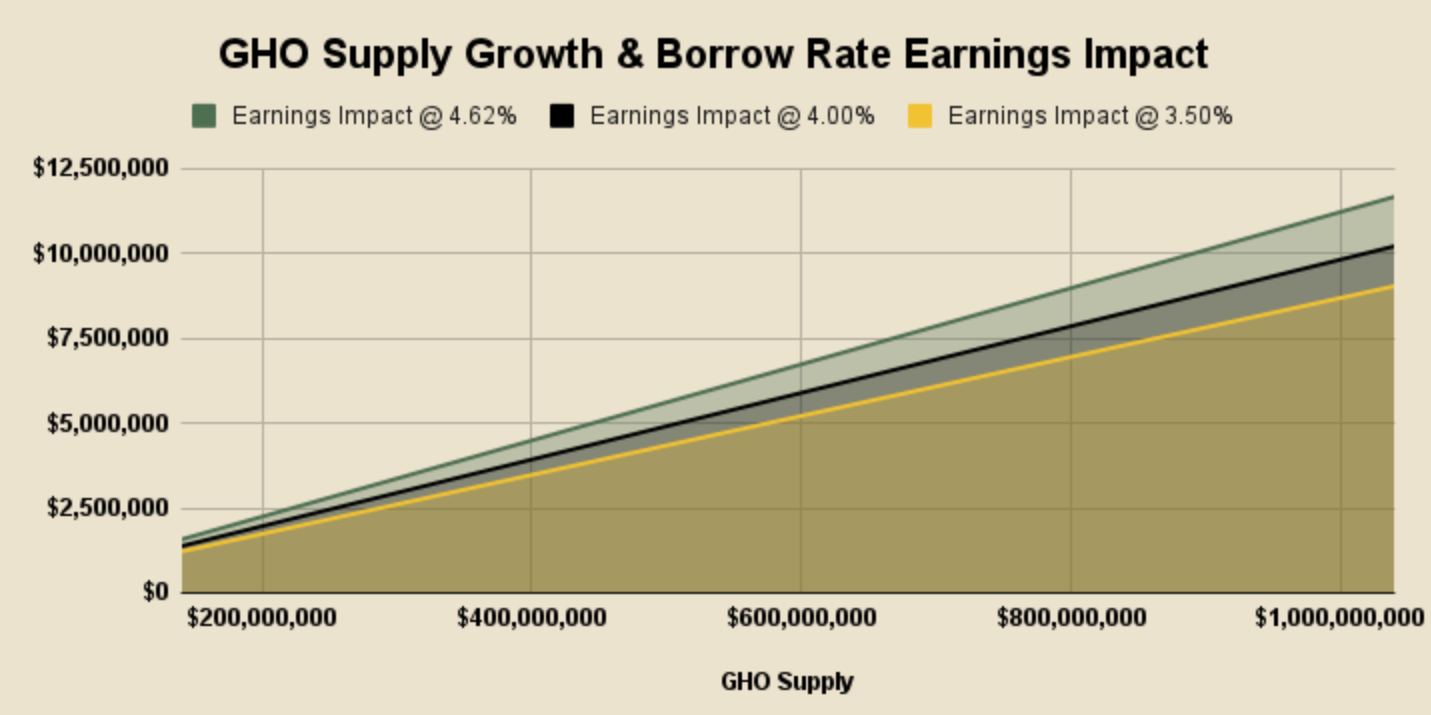
While Aave is clearly in a favorable position for growth, Marc Zeller has proposed a restructuring of protocol expenditures and the native token AAVE on Aave's governance forum. The premise of the restructuring is that Aave is rapidly becoming a profitable protocol but is currently paying too much on an imperfect security module. As of July 25, Aave's security module held $424 million, primarily composed of stkAAVE and stkGHO, which are not ideal for dealing with bad debts due to slippage and decoupling risks. Additionally, through token issuance, the protocol is incentivizing the secondary liquidity of AAVE, thereby minimizing slippage when stkAAVE must be used to cover bad debts.
If the DAO votes to replace the current security module with aTokens like awETH and aUSDC, while reserving stkGHO specifically for covering GHO debt, this concept would undergo a fundamental change. stkGHO would not need to be sold to cover bad debts but would instead be directly confiscated and burned. The aforementioned aTokens are highly liquid and constitute a major part of the protocol's debt. In cases of under-collateralization, these staked aTokens can be confiscated and burned to cover any bad debts. The goal of this proposal is to reduce expenditures on the security module and liquidity incentives while obtaining more effective coverage. Currently, the annual expenditure of the security module is about $44.3 million, and achieving a 10-20% efficiency improvement would have a significant impact on the protocol's profitability and AAVE. Zeller further explains the role of stkAAVE under the new plan in the following diagram.
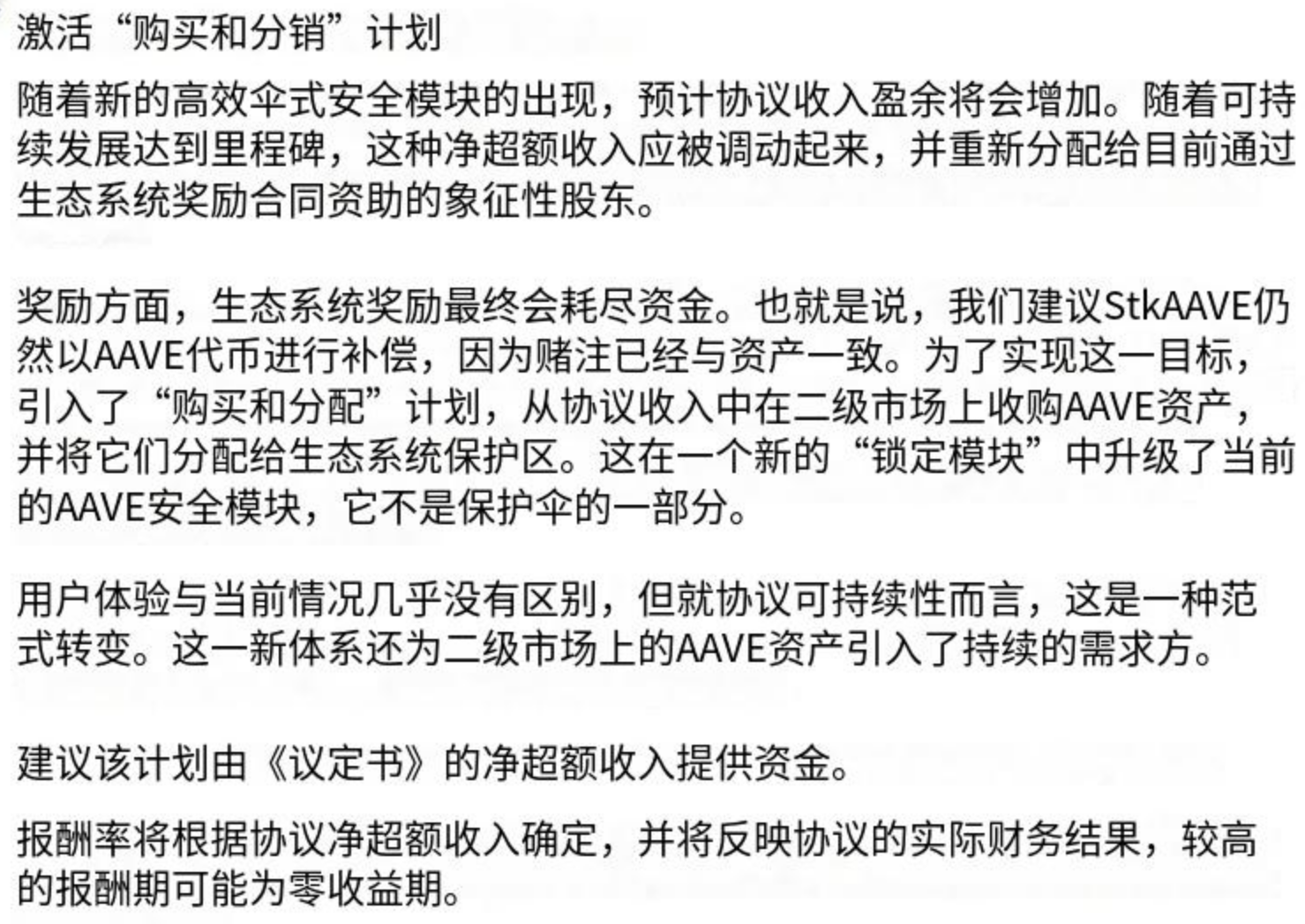
If this proposal is voted through, it should have a beneficial impact on the AAVE token, as it will now have more sustained demand, but it will also allow holders to earn rewards without the downside risk of having stkAAVE confiscated to cover bad debts. We are uncertain about the tax implications of the staked contract wrapping, but it greatly benefits long-term holders of AAVE through continuous buying pressure and reallocating tokens to stakers.
2) ether.fi
Given the protocol's success in rapidly creating a sustainable business model, establishing a revenue multiple for ether.fi is very tempting. For example, the development team and DAO actions of the protocol are extremely swift and are attempting to demonstrate their financial position through a successful proposal, which will use 25%-50% of the income from Restake and Liquid products to buy back ETHFI for liquidity supply and treasury. However, given the lack of AVS rewards, heavy upfront startup costs, and the fact that most of its product suite is brand new, using 2024 revenue data to derive a fair valuation may be futile and complex.
The fully diluted valuation of the ETHFI token is $1.34 billion and is expected to be slightly profitable this year (unless liquidity incentives), making it very similar to Lido's LDO. Of course, ether.fi must withstand the test of time, but given the ongoing success of a broader product base, the protocol seems to achieve profitability faster than Lido and has a higher profit ceiling. Below is a conservative breakdown of how AVS rewards will contribute to the protocol's revenues, not just ETH staking and EIGEN incentives, which should provide the much-needed revenue boost, with a cost base not significantly different from Lido. The AVS reward yield is the rewards that restakers receive solely from AVS payments.
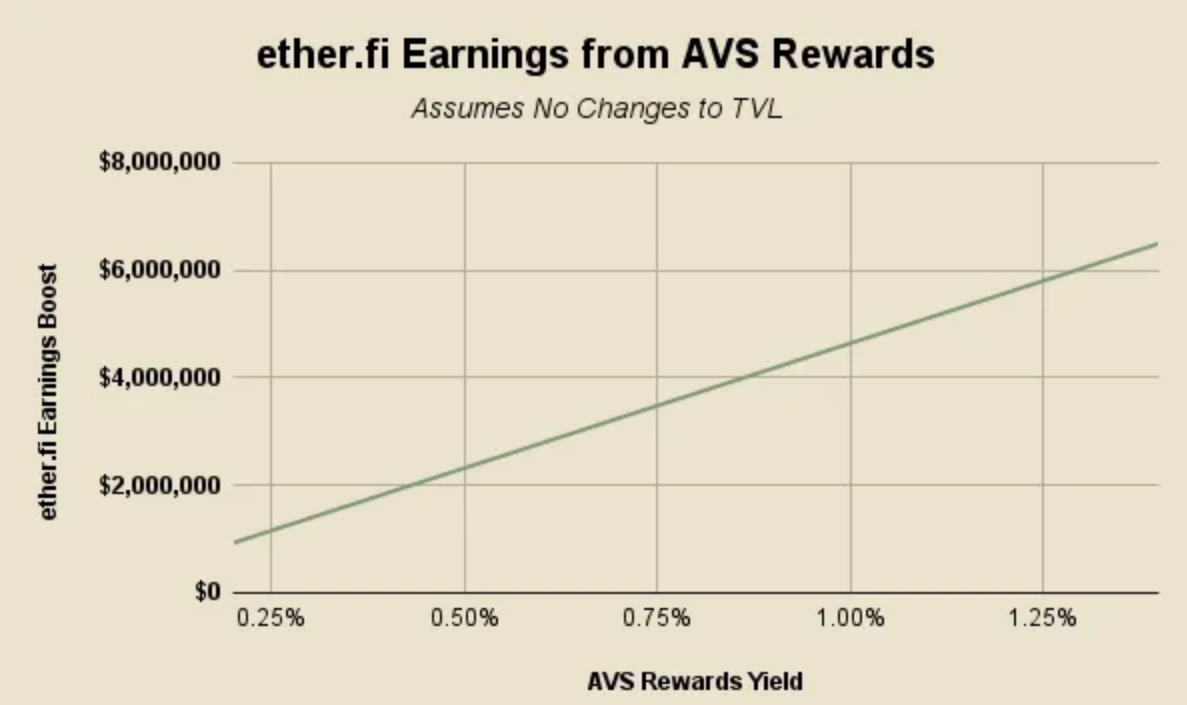
As seen with Lido, liquid staking/re-staking is a highly competitive industry with relatively low margins. ether.fi has a profound understanding of this limitation and focuses on simultaneously dominating market share while building auxiliary products that fit their broader re-staking and yield generation narrative. Here are the reasons we believe these additional products are very suitable for ether.fi:
Liquidity: We firmly believe that LRT advanced users are familiar with DeFi Lego blocks and want to maximize yields, attracting them to products that can automate DeFi strategies. Once AVS rewards truly "go live," there will be dozens of risk/return strategies and a new form of native yield in the crypto economy.
- Cash: Similar to LST, LRT is a better form of collateral than regular ETH because it has sufficient liquidity. Users can use liquid staking as a yield-generating checking account or borrow against their assets for daily consumption at almost zero cost (staking rate - stablecoin borrowing rate).
5. Conclusion
Many of the figures used in this report are subjective, as they are based on partial annual data, trends, market conditions, and discussions with development teams to make predictions. We plan to follow up on this report at the end of 2024 to more accurately depict the situation over the year and analyze the market's response to the growing revenues of these top DeFi protocols.
Link to the article: https://www.hellobtc.com/kp/du/10/5451.html
Source: https://x.com/Kairos_Res/status/1841148057372508555
免责声明:本文章仅代表作者个人观点,不代表本平台的立场和观点。本文章仅供信息分享,不构成对任何人的任何投资建议。用户与作者之间的任何争议,与本平台无关。如网页中刊载的文章或图片涉及侵权,请提供相关的权利证明和身份证明发送邮件到support@aicoin.com,本平台相关工作人员将会进行核查。




